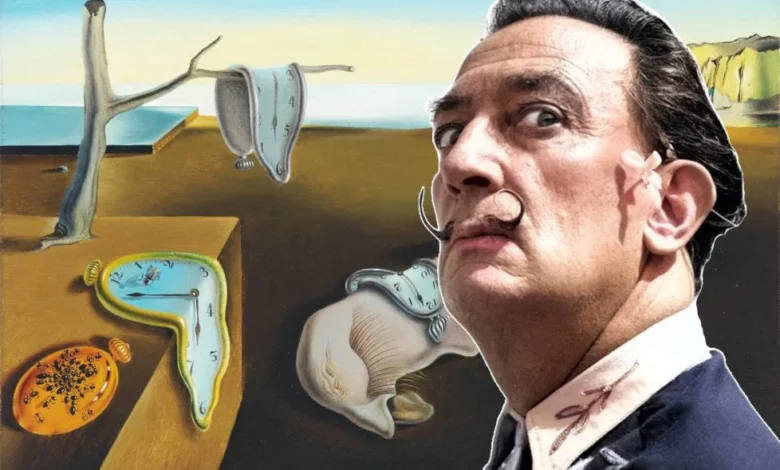Salvador Dalí Paintings: A Journey Through Surrealism

Salvador Dalí, a name that stands synonymous with the surrealist movement, forever changed the world of art with his visionary and eccentric approach. Through his innovative techniques and unique perspective on reality, Dalí created paintings that defy conventional norms, often blending the realms of dreams, fantasy, and subconscious thought. His masterpieces, filled with symbolism and intricate detail, invite viewers into an alternate universe where time, space, and identity are malleable. This article takes you on a journey through the surrealism found in Salvador Dalí paintings and examines some of his most iconic works.
A Brief Introduction to Surrealism
Surrealism is an artistic and literary movement that emerged in the early 20th century, founded by André Breton in 1924. It sought to challenge the boundaries of reality and explore the unconscious mind, dreams, and irrationality. Surrealists believed that the true expression of human creativity could only be achieved by transcending the logical constraints of everyday life.
salvador dali paintings became one of the most prominent figures in this movement, using his paintings as a vehicle to explore the bizarre, often depicting dreamlike scenes that seemed to defy the rules of logic and reason. His works challenged viewers to think deeply about the nature of reality and human consciousness. Dalí’s mastery of technique and his bold imagination made him a central figure in surrealism, and his works continue to captivate and inspire.
The Early Life of salvador dali paintings
Salvador Dalí was born on May 11, 1904, in Figueres, Catalonia, Spain. From a young age, Dalí exhibited a natural talent for drawing, which his father, a strict and disciplined man, nurtured. However, Dalí’s early education at the Royal Academy of Fine Arts in Madrid introduced him to a wide array of artistic styles, including classical art, modernism, and Cubism.
Despite Dalí’s early success, his rebellious and eccentric personality often clashed with the academic and traditional expectations of the institution. He was expelled from the academy in 1926 for challenging his professors’ authority, but this marked the beginning of Dalí’s journey as an avant-garde artist. It was during this time that he began experimenting with surrealism, influenced by the works of other surrealist pioneers like René Magritte, Max Ernst, and Joan Miró.
Salvador Dalí’s Surrealist Masterpieces
Dalí’s paintings have rich symbolism, emotional intensity, and visually stunning detail. His work often incorporates dreamlike imagery, strange proportions, and warped perspectives, inviting viewers to interpret the subconscious meanings hidden within the art. Below are some of Dalí’s most renowned and revolutionary Salvador Dalí paintings:
- The Persistence of Memory (1931)
Undoubtedly one of salvador dali paintings most famous works, The Persistence of Memory (1931) is a hallmark of surrealism. The painting depicts a barren landscape with melting clocks draped over trees and objects. The soft, almost liquid clocks seem to defy the rigid and linear concept of time, which was a central theme in Dalí’s work.
The scene is dreamlike and enigmatic, raising questions about the relativity of time and memory. Salvador Dalí’s use of vivid colors and meticulous detail creates a sense of hyper-realism, even within the surreal environment. The painting’s haunting imagery has made it one of the most recognizable and influential works in the history of art.
- The Sacrament of the Last Supper (1955)
In The Sacrament of the Last Supper (1955), salvador dali paintings reinterprets a classic religious scene with his surrealist flair. The painting features Jesus and his disciples seated at a table, but the setting is transformed into an otherworldly, almost celestial space. The table is set against a translucent dodecahedron (a 12-sided polyhedron), an image that symbolizes Dalí’s interest in both geometry and the spiritual.
Dalí’s incorporation of mathematical precision and his visionary interpretation of a biblical scene showcases his ability to blend the sacred with the surreal. The use of light and shadow, combined with the distorted perspectives, creates a powerful, otherworldly atmosphere.
- The Great Masturbator (1929)
The Great Masturbator (1929) is a deeply personal and psychological painting that delves into Dalí’s fears and desires. The central figure in the painting is a distorted, faceless head, which is surrounded by a series of strange, fragmented images, including a pair of disembodied eyes and a long-legged grasshopper.
This work is a vivid exploration of Dalí’s subconscious mind, filled with symbolic representations of sexuality, anxiety, and repression. The haunting imagery challenges the viewer to confront uncomfortable aspects of human nature and reflects Dalí’s fascination with the complexities of the human psyche.
- The Elephants (1948)
The Elephants (1948) is a striking example of Dalí’s ability to distort reality with surreal proportions and perspectives. In this painting, towering elephants with spindly, insect-like legs are seen carrying obelisks on their backs, which evoke a sense of power and fragility simultaneously. The elephants’ exaggerated size and the peculiar architecture in the background contribute to the painting’s dreamlike quality.
The work can be interpreted as a commentary on the fragility of strength and the illusion of stability. Dalí’s use of symbolism in The Elephants is a testament to his talent for creating deeply philosophical and visually compelling works of art.
- Dream Caused by the Flight of a Bee Around a Pomegranate a Second Before Awakening (1944)
In this fascinating painting, Dalí captures the moment of transition between sleep and wakefulness, where reality becomes distorted, and dreams blend with the waking world. The painting depicts a woman, likely a representation of Dalí’s wife, Gala, who is surrounded by strange imagery, including a pomegranate, a bee, and a pair of fish. The composition is layered with surreal symbolism and intricate details that invite the viewer to reflect on the boundaries between reality and the subconscious.
Dalí’s mastery of technique is evident in the hyper-realistic depiction of the objects in the painting, which juxtaposes the dreamlike qualities of the surreal figures and forms. This work is a perfect example of Dalí’s exploration of time, memory, and the subconscious mind.
salvador dali paintings Artistic Techniques
salvador dali paintings approach to painting was both meticulous and innovative. He employed a wide range of techniques that helped him achieve his highly detailed and lifelike style, which is often referred to as “soft realism.” Here are some key techniques Dalí used in his surrealist works:
- The Paranoiac-Critical Method
salvador dali paintings the paranoiac-critical method to access the unconscious mind and create surreal images. This method involved inducing a state of irrational paranoia, in which the artist deliberately distorted his perception of reality. This process allowed Dalí to create works that contained multiple, conflicting interpretations, revealing the complex layers of meaning embedded in his paintings.
- Precision and Detail
salvador dali paintings works are known for their extreme precision and attention to detail. Even in the most surreal and dreamlike scenarios, Dalí employed sharp, realistic techniques to create depth, texture, and perspective. His ability to paint with photorealistic accuracy in such irrational settings made his works stand out in the art world.
- Use of Symbolism
Dalí often used symbolic imagery in his Salvador Dalí paintings to represent psychological concepts, such as time, death, and desire. Melting clocks, distorted figures, and dreamlike landscapes all carry deep, often personal meaning. These symbols reflect Dalí’s exploration of the human psyche and the surreal nature of existence.
The Legacy of salvador dali paintings
Salvador Dalí’s influence on the world of art is immeasurable. His contributions to the surrealist movement and his innovative techniques paved the way for countless artists who followed. Dalí’s work challenged viewers to think critically about the nature of reality and perception. His Salvador Dalí paintings, full of intricate details and bizarre imagery, remain as relevant today as they were when they were first created.
Dalí’s impact can be seen not only in painting but also in other fields, including film, sculpture, photography, and fashion. His collaboration with filmmaker Luis Buñuel in Un Chien Andalou (1929) further cemented his role as a multifaceted and avant-garde artist.
Today, Dalí’s works are housed in major museums and galleries around the world, including the salvador dali paintings Museum in St. Petersburg, Florida, and the Dalí Theatre-Museum in Figueres, Spain, which he designed himself. His art continues to captivate and inspire generations of art lovers and creators.
Frequently Asked Questions (FAQs)
- What inspired salvador dali paintings surrealist paintings?
salvador dali paintings was inspired by a variety of sources, including dreams, the subconscious mind, and the ideas of psychoanalyst Sigmund Freud. He also drew inspiration from the works of other surrealists and the broader surrealist movement, blending these influences with his unique vision.
- What is the meaning behind The Persistence of Memory?
The Persistence of Memory explores the concept of time and memory. The melting clocks symbolize the fluidity and relativity of time, challenging the viewer’s perception of reality. Dalí’s use of the barren landscape adds to the sense of disorientation and dreamlike unreality.
- What is Dalí’s paranoiac-critical method?
The paranoiac-critical method was a technique developed by Dalí to access his subconscious mind. It involved inducing a state of paranoia and irrationality to allow the artist to distort his perception of reality and create surreal and multilayered images.
- Why are salvador dali paintings paintings so detailed?
Salvador Dalí was known for his hyper-realistic style, even in his most surreal works. His meticulous attention to detail was a key aspect of his artistry, allowing him to create dreamlike scenes that seemed both realistic and fantastical at the same time.
- What is the significance of salvador dali paintings use of symbolism in his paintings?
Dalí often used symbolism to explore complex psychological and philosophical concepts. Objects like melting clocks, distorted figures, and strange landscapes carry deeper meanings related to time, memory, desire, and the subconscious mind.
You May Also Read: https://usasmartnews.com





